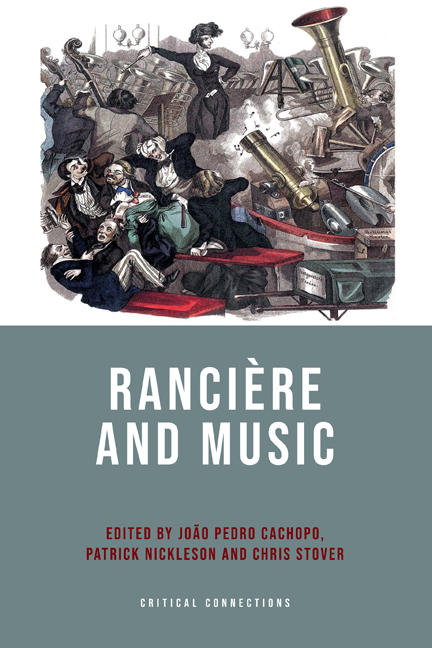Book contents
- Frontmatter
- Contents
- List of Examples
- Acknowledgements
- Notes on Contributors
- Introduction
- Part I: Music and Noise
- 1 Musique concrète and the Aesthetic Regime of Art
- 2 ‘Rip it up and start again’: Reconfigurations of the Audible under the Aesthetic Regime of the Arts
- 3 A Lesson in Low Music
- Part II: Politics of History
- 4 Wandering with Rancière: Sound and Structure under the Aesthetic Regime
- 5 Staging Music in the Aesthetic Regime of Art: Rancière, Berlioz and the Bells of Harold en Italie
- 6 Rancière on Music, Rancière’s Non-music
- 7 Coloured Opera and the Violence of Dis-identification
- Part III: Politics of Interaction
- 8 Musical Politics in the Cuban Police Order
- 9 Rancière and Improvisation: Reading Contingency in Music and Politics
- 10 Rancière’s Affective Impropriety
- Part IV: Encounters and Challenges
- 11 Rancière, Resistance and the Problem of Commemorative Art: Music Displacing Violence Displacing Music
- 12 Stain
- 13 On Shoemakers and Related Matters: Rancière and Badiou on Richard Wagner
- 14 Roll Over the Musical Boundaries: A Few Milestones for the Implementation of an Equal Method in Musicology
- Afterword
- A Distant Sound
- Works Cited
- Index
1 - Musique concrète and the Aesthetic Regime of Art
Published online by Cambridge University Press: 03 October 2020
- Frontmatter
- Contents
- List of Examples
- Acknowledgements
- Notes on Contributors
- Introduction
- Part I: Music and Noise
- 1 Musique concrète and the Aesthetic Regime of Art
- 2 ‘Rip it up and start again’: Reconfigurations of the Audible under the Aesthetic Regime of the Arts
- 3 A Lesson in Low Music
- Part II: Politics of History
- 4 Wandering with Rancière: Sound and Structure under the Aesthetic Regime
- 5 Staging Music in the Aesthetic Regime of Art: Rancière, Berlioz and the Bells of Harold en Italie
- 6 Rancière on Music, Rancière’s Non-music
- 7 Coloured Opera and the Violence of Dis-identification
- Part III: Politics of Interaction
- 8 Musical Politics in the Cuban Police Order
- 9 Rancière and Improvisation: Reading Contingency in Music and Politics
- 10 Rancière’s Affective Impropriety
- Part IV: Encounters and Challenges
- 11 Rancière, Resistance and the Problem of Commemorative Art: Music Displacing Violence Displacing Music
- 12 Stain
- 13 On Shoemakers and Related Matters: Rancière and Badiou on Richard Wagner
- 14 Roll Over the Musical Boundaries: A Few Milestones for the Implementation of an Equal Method in Musicology
- Afterword
- A Distant Sound
- Works Cited
- Index
Summary
In this essay, I propose to think about the emergence of musique concrète following the propositions of Jacques Rancière on the aesthetic regime of art. Starting from a text by Pierre Schaeffer on radio, I first highlight the overthrow of muthos (the plot or the narrative) in favour of opsis (the sensible) that conditions the possibility of musique concrète. I show how this overthrow traces a thread in the formation of musique concrète through different displacements that took shape in literature, radio and cinema, as well as in the field of sound composition. In doing so, I detail some aspects of a distribution of the sensible that Schaeffer articulates and I show how it belongs to the aesthetic regime of art. The very idea of sound specific to musique concrète or the concept of the ‘sound in itself’ will then appear as resulting from a singular configuration or redistribution of the sensible, where the visible and the audible interweave or oppose each other, where words can become noise and things, making sense or not of the sensible. Through this discussion, we will see that Rancière's propositions can shed new light on musique concrète, recapturing its possibilities, its conditions and its limits.
The background and the narrative
Let's take an example. The scene takes place in Champs-Élysées, on November 11th. By chance or by my own free will, I am physically present at the ceremony. For better or for worse, I participate in it: they elbow me, they jostle me, they walk on my feet, and moreover, I do not see much. I make a very practical use of my sonorous and visual perceptions to protect myself on the one hand, and on the other hand, to satisfy the curiosity, which is certainly vain, but almost automatically occupies me. Where are we? What is happening? This waving flag, this music, these applauses or this sudden rumor, so many signs immediately interpreted and forgotten in the expectation of the continuation … Comfortably installed in the penumbra, I attend the same parade that presents me the Newsreel. I do not participate, I attend the event: it is banal. Without anything unforeseen, everyone holds his role
- Type
- Chapter
- Information
- Ranciere and Music , pp. 27 - 46Publisher: Edinburgh University PressPrint publication year: 2020



